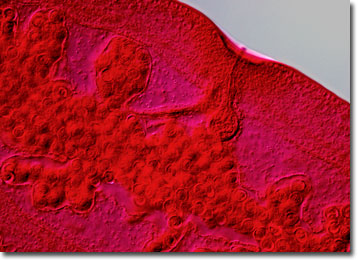Differential Interference Contrast Image Gallery
Canine Tapeworm (Echinococcus granulosus)
Echinococcus granulosus is a tapeworm species that parasitizes dogs and other canines in its adult stage of life. The adult form, however, is relatively benign compared to larval members of the species that infect sheep, horses, humans, and other intermediate hosts.

Canines become infected with E. granulosus by eating the contaminated flesh of an intermediate, cyst-infested host. The cyst wall is then digested and the larvae it contains are released. The larvae migrate deep into the crypts of Lieberkuhn and develop into adult tapeworms within seven to nine weeks. Infection in definitive hosts is usually asymptomatic, but may cause inflammation of the intestinal wall and digestive irritation in serious cases.
The mature E. granulosus worm consists of three to five segments, generally reaching approximately five millimeters in length. The scolex of the organism is globular in shape and features a prominent projection known as a rostellum that is lined with a double row of hooks. The hooks enable the parasite to firmly lodge itself into the tissues of its host. The eggs produced by the adult parasites and expelled from the definitive host with bodily wastes are extremely resilient, surviving for up to a year even in very poor environmental conditions. Over that time, suitable intermediate hosts may accidentally consume them, which allows the parasitic lifecycle to continue on unabated.
